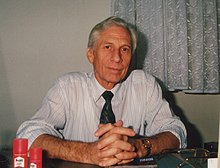Klaus Rühlmann
Klaus Rühlmann (born November 8, 1929 in Neumark im Geiseltal ) is a German chemist ( organosilicon chemistry ) and professor emeritus at the Technical University of Dresden .
Career
After graduating from high school in Halle, he studied biology from 1948 and chemistry from 1949 at the Martin Luther University in his hometown. Rühlmann graduated there in 1953 under the guidance of his teacher Wolfgang Langenbeck , after he had already started an assistant position at the Institute for Organic Chemistry in 1952. In 1956 he received his doctorate at the same institute. Diploma and doctoral theses dealt with topics of organic and bio-organic chemistry. Until 1961 he supervised Friedrich Asinger's graduate students as senior assistant .
Rühlmann achieved international fame at the beginning of his research work with the hitherto unknown silylation and gas chromatographic separation of amino acids. From 1960 he dealt with the synthesis of acyloin by converting carboxylic acid esters with sodium (Bouveault-Blanc condensation) and subsequent hydrolysis. What was new was that he used trimethylchlorosilane as a trapping reagent. This enabled base-catalyzed side reactions to be avoided, the yields of the desired product to be greatly increased and the scope of the classic Bouveault-Blanc condensation to be expanded. This reaction later entered books as the Rühlmann condensation .
In 1961 he completed his habilitation on these topics and was not quite 32 years old when he was appointed professor at the University of Transport in Dresden. A year later, I was offered a professorship at the Second Chemical Institute at the Humboldt University in Berlin . In Berlin, Rühlmann mainly dealt with optically and biologically active silicon compounds.
With the university reform and the associated profile changes, Rühlmann came to the Technical University in Dresden and was able to build on traditions in the field of silicone chemistry. Richard Müller had given lectures on this subject at the Technical University from 1954 to 1968. Together with Eugene G. Rochow from the USA, Müller is the inventor of the "direct synthesis" of chloromethylsilanes from chloromethane and silicon. It is thanks to Müller that the Institute for Silicone and Fluorocarbon Chemistry was founded in Dresden-Radebeul and that silicone production was started in the heavy chemicals plant of the former Heyden chemical factory in Nünchritz (later VEB Chemiewerk Nünchritz).
The cooperation with the institute in Radebeul and the chemical plant in Nünchritz, which had been going on since 1959, has now been further strengthened by the local proximity, which also led to a shift towards industry-related research.
In 1978, a problem laboratory of the Nünchritz chemical plant at the TU Dresden was founded under his leadership. The main research topics in Dresden were: kinetic studies on basic reactions in silicone production, kinetics and stereochemistry of the nucleophilic substitutions of organosilicon compounds, siloxane-bonded polymer stabilizers, sulfur-containing silane adhesives, production of telechelic siloxanes with C and Si functional groups, synthesis of polycarbosiloxanes and precursors for the production of ceramic silazanes Composite materials and recently again the synthesis and testing of biologically active silicon compounds.
After the fall of the Berlin Wall, years of work in applied chemistry enabled cooperation agreements with Goldschmidt-AG, Bayer, Bosch and Ciba-Geigy. There were also projects funded by the BMFT, DFG and the VW Foundation.
Rühlmann has supervised 45 doctoral students and 2 post-doctoral students, written almost 150 publications and 40 patents and published the German edition of Michail G. Voronkov's book "Silicon and Life" and two conference volumes (Silicone Colloquium, KOSIL).
Rühlmann is married and has 3 daughters.
Footnotes
- ↑ K. Rühlmann: Reaction of carboxylic acid esters with sodium in the presence of trimethylchlorosilane. In: Synthesis - International Journal of Organic Chemistry. 5 (1971), p. 236 ff.
| personal data | |
|---|---|
| SURNAME | Rühlmann, Klaus |
| BRIEF DESCRIPTION | German chemist (organosilicon chemistry) and university professor |
| DATE OF BIRTH | November 8, 1929 |
| PLACE OF BIRTH | Neumark in the Geiseltal |
